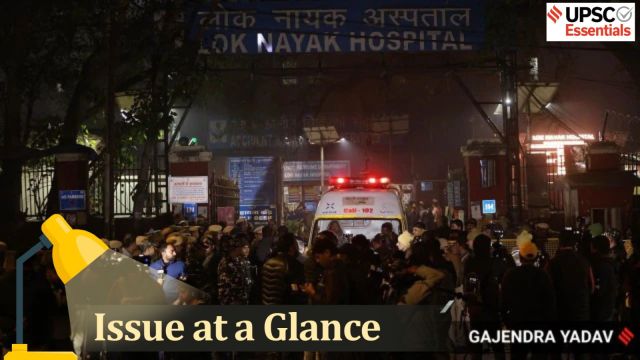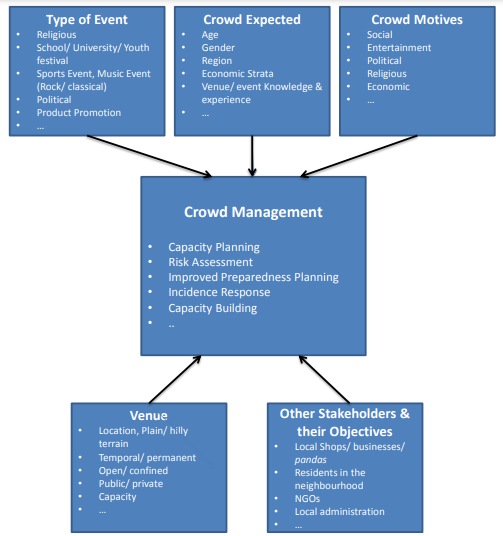
Why is this issue relevant?
The issue of stampedes is significant for UPSC CSE aspirants as it pertains to disaster management, governance, and public safety measures. Understanding the causes, preventive strategies, and case studies related to stampedes can help address questions on governance, ethical responsibilities, and disaster preparedness in both the mains examination and interviews.
UPSC Syllabus:
Preliminary Examination: Current events of national importance
Mains Examination: General Studies-II, III: Government policies and interventions, Disaster Management.
Question 1: What is a stampede?
Wenguo Weng and others define a stampede as “an impulsive mass movement of a crowd that often results in injuries and deaths” (“Review of analyses on crowd-gathering risk and its evaluation methods”, 2023).
According to Illiyas and others, “Stampede is the surge of individuals in a crowd, in response to a perceived danger or loss of physical space. It often disrupts the orderly movement of crowds resulting in irrational and dangerous movement for self-protection leading to injuries and fatalities”.

Stampedes have high mortality rates and are, along with heat-related illnesses, the most common causes of death at mass gatherings.
Story continues below this ad

Question 2: What are the factors leading to stampedes?
Crowd management is a crucial tool for ensuring the safety of citizens during various types of mass gatherings. Unfortunately, stampedes still occur. According to nidm.gov.in, such unfortunate events happen due to a lack of (i) understanding of crowd behaviour, (ii) coordination, (iii) clear roles & responsibilities of various stakeholders, and (iv) proper planning on the part of organizers. Some of the factors leading to stampedes are:
1. Human Psychology: Human psychology is an important factor leading to stampedes, as all stampedes are either triggered or made worse by panic. In a seminal paper, psychologist Alexander Mintz theorised that “in panic-producing situations, cooperative behaviour is needed for success and is rewarding to individuals as long as everybody cooperates. However, once the cooperative pattern of behaviour is disturbed, cooperation ceases to be rewarding to the individuals” (“Non-adaptive group behaviour,” 1952).
Some stampedes may also be triggered by what sociologist Neil J. Smelser refers to as a “craze.” In Theory of Collective Behaviour (1962), he defined the term as “[the] mobilisation for action based on a positive wish-fulfilment belief.” This belief can be rational or irrational. But in large group settings, it percolates to every member and can make them act in the detriment of their interests.
 Crowd disaster process. (Source: Guide for Managing Crowd at Events and Venues of Mass Gathering by NDMA)
Crowd disaster process. (Source: Guide for Managing Crowd at Events and Venues of Mass Gathering by NDMA)
Take for example what happened in Hathras. Uttar Pradesh Chief Secretary Manoj Kumar Singh, after visiting the site of the tragedy, said: “I am told that people rushed to touch his [the preacher’s] feet and tried to collect soil [from where he walked], and a stampede took place”.
Story continues below this ad
2. Structural Issues: In addition to human psychology, the structural issues play a significant role in contributing to stampedes. Chun-Hao Shao and others have listed a number of factors in their paper “Stampede Events and Strategies for Crowd Management” (2018) that lead to human stampedes. These include:
📍Lack of light
📍Crowd flow not being divided for different crowds
📍Collapse of barriers, buildings
📍Blocked exits, evacuation route
📍Poor design of hardware (such as a revolving door at the entrance)
📍Fire hazards
3. High Crowd Density: Crowd density, defined as the number of people per unit area, plays a crucial role in determining how spaces for mass gatherings should be organized. When the crowd density exceeds the available space, it can create panic among attendees, especially if crowd management is lacking. This situation can sometimes lead to dangerous outcomes, such as stampedes.
According to Chun-Hao Shao and others’ simulation, “When the density approached 3 and 4 persons/ sq m, most cases spent over 8 min in evacuation… If evacuees spend too much time waiting for evacuation or are blocked near the exit, crowd panic will increase, as will stampede risk”.
Story continues below this ad
Therefore, it is evident that various factors contribute to the occurrence of a stampede.
Question 3: What are the NDMA guidelines for crowd management in India?
Crowd management is defined as a systematic process of planning, organizing and monitoring large gatherings. Such management must be anticipated and planned accordingly for the worst situation and therefore should strategise to reduce and mitigate the risks in advance.
Recognising the issue of recurring stampedes at mass gatherings, the National Disaster Management Authority (NDMA) has issued guidelines for crowd management. The objective of these guidelines is to assist all stakeholders, including state governments, local authorities, and organisers/administrators of events and venues of mass gatherings, in overall planning and establishing required systems for effective crowd management.
1. Capacity Planning: For effective management of the crowd, an effective method for counting and monitoring visitors passing through a staging point should be implemented to manage the flow. Ensure that there are designated physical or virtual locations that each visitor must pass through. Each staging point should provide adequate facilities for resting, eating, drinking water, and maintaining hygiene. Additionally, it is important to encourage multiple routes to enhance visitor movement and reduce congestion.
Story continues below this ad
2. Crowd Control: During the crowd control focus should be on managing the demand-supply gap through: i) controlling crowd inflow, ii) regulating crowd movement at the venue, and iii) managing crowd outflow if necessary.
3. Conducting Hazard, Risk and Vulnerability analysis (HRVA): To transition from the traditional “crowd control” approach to a more effective “crowd management” strategy, strategic planning is necessary at all levels—from the events and venues where large gatherings occur to district and state-level disaster management plans. Conducting HRVA for mass gathering locations, along with pre-event scenarios can provide a foundation for preparing for all three phases of any severe incident: response, recovery, and mitigation.
The HRVA can facilitate the creation of a decision support system that can enhance the efficiency and effectiveness of rescue and relief operations during crowd-related disaster scenarios.
(i) Identifying Threats and Causes: Planners can utilize existing information to recognize a variety of potential threats and causes of disasters at places where large crowds gather.
Story continues below this ad
(ii) Risk Assessment and Planning: After identifying these potential threats and causes, it is essential to assess their risks.
 Integrated Approach for Crowd management. (Source: Guide for Managing Crowd at Events and Venues of Mass Gathering by NDMA)
Integrated Approach for Crowd management. (Source: Guide for Managing Crowd at Events and Venues of Mass Gathering by NDMA)
4. Failure Mode and Effect Analysis (FMEA): NDMA has recommended that all event organizers/planners conduct FMEA. This methodology involves rating every possible hazard on the dimensions of a) Severity, b) Frequency of Occurrence, and c) Difficulty of detection on a scale of 1-10 to arrive at an overall Risk Priority Number (RPN).
Higher the severity, higher the frequency of occurrence, higher the difficulty of detection, the score assigned would be higher. The basic premise is that if a disaster can be foreseen, the probably of occurrence is high. For every hazard, actions are then warranted to reduce/remove the risks.
5. Develop a Course of Action: A course of action should be created to address each threat, cause, or gap identified by FEMA. After selecting potential courses of action, the planning team should identify the resources required for each option and assess them against the resources available.
Story continues below this ad
Question 4: What should be done for effective crowd management and preventing stampedes?
As the human population continues to grow and travel increases, mass gatherings are becoming more frequent and attracting larger numbers of participants. These gatherings can be spontaneous, such as those that occur at train stations during rush hour, or they can be planned events, like sports, religious, cultural, or political gatherings. Regardless of the type of mass gathering, effective strategy for crowd management is essential for preventing stampedes.
In an ideal situation, planners/organizers should limit the number of people allowed to enter a confined space. However, this is not always feasible. In those cases, the number and location of exits become critical. Additionally, the vigilance of event organizers, along with monitoring and real-time preventive measures, is essential. Following measures can be taken for management of mass gatherings:
1. Stampede Risk-Reduction Framework: Having the right framework for planning mass gatherings is crucial, as it involves an inter-agency, multi-disciplinary approach that relies on identifying potential hazards to design and implement appropriate mitigation measures, as noted by Illyas and others. They have also developed a stampede risk-reduction framework.
 Framework for stampede prevention (Illyas et al)
Framework for stampede prevention (Illyas et al)
2. Better Design of Spaces: Improving the physical organization and design of spaces is essential for effective crowd management. Many stampedes can be prevented by enhancing the design of areas meant for mass gatherings, as well as locations where gatherings may occur spontaneously. For instance, having sufficient exits can help in crowd movement.
Story continues below this ad
3. Live Surveillance of the Crowd: The live surveillance of the crowd can help organizers monitor crowd density, bottlenecks, pressure buildup, and identify the source of disturbances which can help in better crowd management.
4. Inter-agency Communication: Effective communication among organizers and the crowd is essential. It is crucial for organizers, who often represent different bodies such as temple authorities, local administration officials, and police, to communicate clearly. Additionally, organizers must be prepared for situations that may require issuing warnings to the crowd. They need to establish who will be responsible for issuing the warning and determine how the crowd will be informed.
Express View: Lessons from the Hathras stampede
Religious gatherings, festivals, weddings and functions that draw large crowds are a regular part of the cultural, political and religious calendars of almost every district, or even neighbourhood, in the country… Authorities must be stringent about the size of a gathering. However, the administrative and police machinery is not always equipped to ensure that the crowd does not swell beyond the sanctioned numbers. In such situations, the number and placement of exits at the event are crucial, as are real-time interventions to ensure that religious or cultural fervour does not imperil public safety. Healthcare facilities should be kept on alert. Authorities across the country must ensure that mass gatherings do not turn chaotic and take such a high toll.
Post Read Questions
Discuss the recent measures initiated in disaster management by the Government of India departing from the earlier reactive approach. (UPSC CSE 2020)
Crowd management is an important tool for safety of citizens especially at religious places. Unfortunately crowd disasters still happen. What are the major reasons behind such disasters. Suggest strategies to avoid crowd disasters.
(Sources: Hathras stampede kills over 100: Why stampedes take place, Express View: Lessons from the Hathras stampede, UPSC Essentials | Case Study — IAS officer who conducted ‘Sabarimala Yatra’ through strategic planning, ndma.gov.in)
For your queries and suggestions write at roshni.yadav@indianexpress.com
The Indian Express UPSC Essentials brings to you the December issue of its monthly magazine. Click Here to read. Share your views and suggestions in the comment box or at manas.srivastava@indianexpress.com
Subscribe to our UPSC newsletter and stay updated with the news cues from the past week. Stay updated with the latest UPSC articles by joining our Telegram channel – Indian Express UPSC Hub, and follow us on Instagram and X.





 Crowd disaster process. (Source: Guide for Managing Crowd at Events and Venues of Mass Gathering by NDMA)
Crowd disaster process. (Source: Guide for Managing Crowd at Events and Venues of Mass Gathering by NDMA) Integrated Approach for Crowd management. (Source: Guide for Managing Crowd at Events and Venues of Mass Gathering by NDMA)
Integrated Approach for Crowd management. (Source: Guide for Managing Crowd at Events and Venues of Mass Gathering by NDMA) Framework for stampede prevention (Illyas et al)
Framework for stampede prevention (Illyas et al)






























